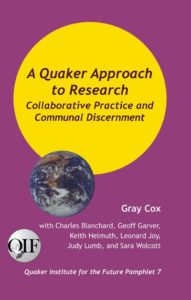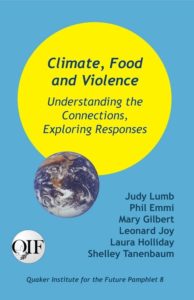A Quaker Approach to Research, and Climate, Food, and Violence
Two titles reviewed by Philip Favero
November 1, 2016
 A Quaker Approach to Research: Collaborative Practice and Communal Discernment
A Quaker Approach to Research: Collaborative Practice and Communal Discernment
By Gray Cox, with Charles Blanchard, Geoff Garver, Keith Helmuth, Leonard Joy, Judy Lumb, and Sara Wolcott. Quaker Institute for the Future Focus Book 7, 2014. 74 pages. $12/paperback; free PDF available at quakerinstitute.org.
Buy from QuakerBooks Climate, Food, and Violence: Understanding the Connections, Exploring Responses
Climate, Food, and Violence: Understanding the Connections, Exploring Responses
By Judy Lumb, Phil Emmi, Mary Gilbert, Leonard Joy, Laura Holliday, and Shelley Tanenbaum. Quaker Institute for the Future Focus Book 8, 2014. 83 pages. $12/paperback; free PDF available at quakerinstitute.org.
Buy from QuakerBooksAs science advances and evidence of global warming mounts, Friends’ peace testimony will lead us to a particular concern about a predictable consequence of a warming Earth: the collapse of food systems. People who struggle over reduced resources in desperate attempts to feed their hungry families are people inclined to violence. Food-related violence is not a theoretical concern for some time in the future. In an article titled “Climate change in the Fertile Crescent and implications of the recent Syrian Drought,” published in 2015 by the National Academy of Sciences, for example, Colin P. Kelley et al. cite evidence that “human influences on the climate system are implicated [via a 2007-2010 drought] in the current Syrian conflict.”
Writing for the Quaker Institute for the Future (QIF) in Focus Book 8, Judy Lumb, Phil Emmi, Mary Gilbert, Leonard Joy, Laura Holliday, and Shelley Tanenbaum provide a guide for Friends concerned about global warming, food, and violence. In Climate, Food, and Violence Lumb et al. deliver—in less than 100 pages of text—insights, analyses, and ideas for action. They pack into their booklet thoughtful, well-referenced sections on the science of climate change, its relation to food production, corporate control of food systems, methods for responding to problems, and a menu of practical actions for “the way forward.”
The authors are particularly insightful about the institutional framework that allows international corporations to enhance their profits while displacing small farmers and mining the natural resources of poor countries. The authors propose actions on behalf of food security and peace. They include the categories of international human rights, international climate agreements to reduce carbon emissions, and the defeat of climate change deniers. They explain efforts to deflate the power of corporations, reform agriculture, and restore America’s social safety net. Readers will find in QIF Focus Book 8 a brief but comprehensive guide to climate, food, and violence. For Friends concerned about the rapidly emerging threat of food systems collapse, I highly recommend reading it.
Climate, Food, and Violence was the product of collaborative research and discernment by a group of Friends. Prior to its publication, Gray Cox, Charles Blanchard, Geoff Garver, Keith Helmuth, Leonard Joy, Judy Lumb, and Sara Wolcott wrote about such collaborative efforts in their booklet A Quaker Approach to Research, which is QIF Focus Book 7. Conventional wisdom has it that scientific research and spiritual discernment are two separate ways of knowing. Cox et al. make the case, however, that science and Quaker discernment can be understood as complementary methods for knowing, and that Quaker processes can enhance scientific research.
Focus Book 7 begins with a description of Quaker belief in continuing revelation and the practice of silent worship. The authors next describe variations of “meetings for worship for the conduct of research.” Examples of such meetings include clearness committees for ethnographic research, research seminars, and a book-writing project.
In making the case for using Quaker processes to enhance scientific efforts, the authors first argue that Quaker processes can be employed in the process of scientific discovery: to open the minds of researchers to “get along well, empower each other, and generate lots of new ideas.”
To argue the more difficult case that Quaker processes can also be usefully employed in the process of scientific justification, the authors first suggest the benefits of applying such processes to collaborative discernment about multidisciplinary problems. They note, “Communal discernment is understood here not as a substitute for scientific research, but as a way of making the character of its soundest traditions explicit and enhancing them in ways that promote open dialogue that aims at unity among participants and truth.”
Next, Cox et al. extend their argument by considering the biological concept of “design space,” defined as a time of discovery, adaptation, and behavioral improvement, a time “for the exploration not only of what are the facts on the ground in the present, but what are the possibilities . . . of the future.” For this reader, design space brings to mind the situation humanity now faces when, by our own hand, we are ending the Cenozoic (Mammal) Era by a mass extinction event, just as it dawned, 65 million years ago with the death of the dinosaurs and other forms of life. At this time, we will either design the future, or let it happen to us. As Joanna Macy, the environmental activist and scholar of Buddhism, writes, “There’s a song that wants to sing itself through us. We just got to be available. Maybe the song that is to be sung through us is the most beautiful requiem for an irreplaceable planet or maybe it’s a song of joyous rebirth as we create a new culture that doesn’t destroy its world.”
I find myself open to the argument of Cox et al. that design space calls for communal discernment of leadings that, in the case of the ending of the Cenozoic Era, seeks economic, ethical, physical, religious, and other contributions to stop the dead-end degradation of Earth’s ecosystems. Finally, Cox et al. argue that scientific research on human communities would benefit from shared inquiry, with respect for participants’ “Inward Light,” that establishes what is presupposed but often not present: the transforming power of “I-Thou” relationships. I-Thou relationships, as defined by Martin Buber, are characterized by honest, open, and authentic dialogue, and they stand in contrast to I-It relationships in which the “it” is treated as an object of thought or action. Thus research which involves I-Thou relationships would hold the potential for transforming experiences based on mutual honesty, spontaneity, and respect, leading to empathetic understanding.
Focus Book 7 will not, I wish, be the final word on a Quaker approach to research. Hopefully, Cox et al. will continue to think, research, and write about that subject. I recommend the book to Friends who are seeking ways to integrate their Quaker faith and practice with their respect for science. My personal experience is that the two ways of knowing are, indeed, complementary, and that with the end of the Cenozoic Era, we need all of the power of collective discernment available to avoid a global catastrophe.



Comments on Friendsjournal.org may be used in the Forum of the print magazine and may be edited for length and clarity.